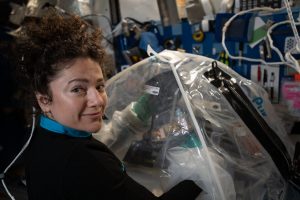“Regenerative medicine news under the microscope” is a new monthly feature highlighting big stories in stem cell research. I will sample the latest and greatest findings in recent press and package them into a single post.
This month I cover stem cells in space, controversial revisions to the 14-day rule, cancer vaccines, and much more!

Jessica Meir, astronaut and flight engineer with NASA, sets up equipment to conduct cardiac stem cell research aboard the International Space Station. Source: NASA.
The terrestrial benefits of stem cell research – in space.
Have you ever wondered what happens to stem cells in microgravity?
An investigation by NASA called MVP Cell-03 was designed to answer this question. Heart precursor cells are cultured on the International Space Station to determine how cell survival and cell proliferation is affected by microgravity. Interestingly, prior studies had shown that culturing these cells in simulated microgravity actually increased their production efficiency.
As you can imagine, sending cells up to space without killing them is a difficult task. How did scientists solve this problem? The same way we protect cells when shipping them between cities and countries: cryopreservation. Not only was this protocol not found to affect the cells adversely, but it also protected the cells from the extreme gravity during launch.
How does this help us earthling researchers? The team also developed a culture medium that supports cells without necessitating carbon dioxide. Carbon dioxide adds mass to any payload – more mass, more money spent.
The above strategies were successfully applied in March 2020 to generate beating heart cells – in space – which journeyed back to Earth after 22 days in orbit. NASA is reporting the results now so that the findings might help other teams, both on the ground and in the sky.
Lab-grown human embryos, the 14-day rule, and the ISSCR.
You’ve likely seen the headlines flash across your screen recently. On May 26th, the International Society for Stem Cell Research (ISSCR) made the decision to revise their rule limiting the growth of lab-grown embryos to 14 days. This was done in response to rapid advances in technology and outstanding questions in the field.
The issue that many have taken with this course of action is that the limit was not replaced, nor extended. The ISSCR recommends that each study seeking an extension to the rule should be individually evaluated and peer-reviewed to determine suitable endpoints. As one might imagine, although resultant research could yield immense insights into developmental biology, some researchers are worried about the ethics of relaxing the 14-day rule, especially in the absence of alternative guidelines.
For in-depth coverage of this issue, head over to Nature or The Niche.
Combatting stressors in the hPSC environment.
Human pluripotent stem cells (hPSCs) are highly sensitive to their environments. Cellular stress and DNA damage may be induced during an experiment or procedure, resulting in cell death or a reduction in culture quality. To combat these issues, a small-molecule cocktail called CEPT has been developed to safeguard stem cells in culture. CEPT was found to reduce cell damage and loss induced by cryopreservation, in addition to improving the viability and function of differentiated cells. The reported benefits don’t stop there; the authors also found that CEPT improves outcomes during cell passaging, organoid formation, genome editing, and more. Get more details about CEPT from blogger Tara Fernandez, here.
Cardioids: Beyond mathematics.
Up until recently, cardioids were exclusively known to the world of mathematics as a somewhat heart-shaped pattern generated by rolling one circle along the perimeter of another circle with the same radius. The result is a beautiful, intricate structure studied by high-level mathematicians.
This month, the definition of the term cardioid was expanded to include the newly developed heart organoids published by Hofbauer et al. in Cell. These cardioids self-organize to form a cavity and, importantly, show architecturally-appropriate lineage specificity.
Demonstrating the usefulness of their system, the authors report a molecular mechanism for cavity formation, and describe the cellular response of the cardioids to cryoinjury. In future, this system could easily be adapted to study both development and heart disease in vitro.
iPSC-based pancreatic cancer vaccine effective in mouse models.
Vaccines are a hot topic these days. But among what may be the most important vaccines of our time lie cancer vaccines, which prime the body to recognize and attack cancer cells through immune mechanisms.
A team at Stanford University based this new research on previous findings which showed that induced pluripotent stem cells (iPSCs) and cancer cells possess similar gene expression profiles to one another. When their iPSC-based vaccine was administered together with a specific vaccine adjuvant (any substance that enhances an individual’s physiological response to an antigen from the vaccine itself), pancreatic tumour formation was prevented in 75 per cent of mice that would usually be prone to this disease (a mouse model of pancreatic cancer was used in these experiments). These are fantastic results, but the authors emphasize that further study is required in pre-clinical and clinical settings.
They also mention that other types of cancer may benefit from similar treatment systems.
Additional recommendations
Here are some papers/headlines that I didn’t have room for above:
Latent inflammatory potential of adult neural stem cells – suppressed during neurogenesis. Shariq et al. in Science Advances.
Ethically problematic payments issued to participants in a stem cell study. Turner and Snyder in STEM CELLS Translational Medicine.
Paper touting stem cell therapy for arthritis: Retracted. Michael Hiltzik in The Los Angeles Times.
Deep neural net tracking of hPSCs. Joy, Libby, and McDevitt in Stem Cell Reports.
Medicine by Design (UofT) invests $3M in regenerative medicine research. University of Toronto News.
World’s largest cancer hospital to be inaugurated in Egypt by Cairo University. Egypt independent.
Stay tuned for my next post, coming up in June!






Comments